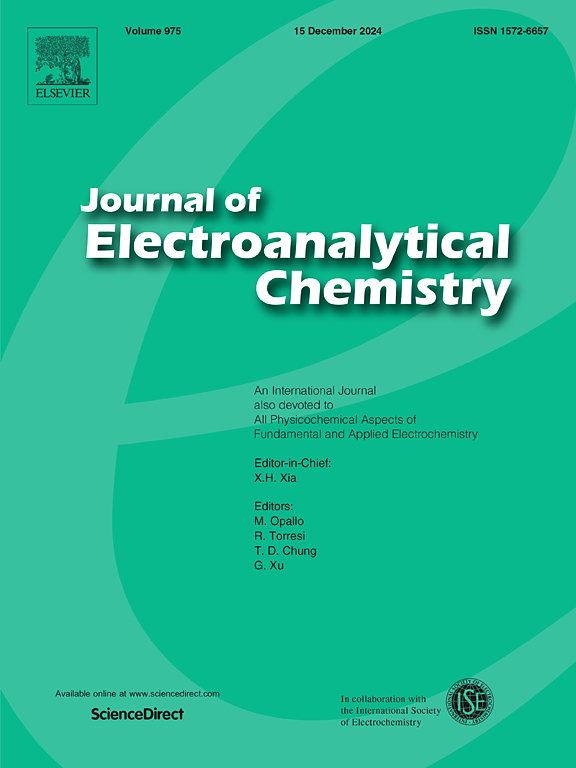Oxalic acid enhanced nano zero-valent iron for Electrocatalytic nitrate reduction to Ammonia
IF 4.1
3区 化学
Q1 CHEMISTRY, ANALYTICAL
引用次数: 0
Abstract
Ammonia (NH3), a widely used chemical product, has various applications in numerous fields. However, the high energy consumption of the traditional ammonia synthesis process is inconsistent with the pursuit of “zero carbon,” and there is an urgent need for a new method to synthesize NH3. The electrocatalytic NO3−-to-NH3 (NITRR) offers an ideal route to synthesizing NH3 under ambient conditions. Nano zero-valent iron (nZVI) has been widely used in nitrate wastewater treatment due to its environmental friendliness, low cost, and high activity. However, nZVI is difficult to recover and prone to deactivation because of its tendency to corrode and agglomerate. Here, we report a method to enhance the activity and stability of nZVI through oxalic acid modification. In this study, oxalic acid and citric acid modified nZVI on foam nickel substrates (OA-nZVI/NF) was examined as examples. Experiments confirmed that the Faraday efficiency of NH3 (FENH3) from OA-nZVI/NF was 84.9 %, respectively, at −0.4 V vs. RHE, which was significantly higher than that of nZVI/NF (64.5 %). More importantly, the FENH3 of OA-nZVI/NF electrod did not decrease significantly after continuous electrolysis for 100 h. Subsequently, electrochemical characterization and control experiments revealed that oxalic acid modification reduced the corrosion potential of nZVI/NF and promoted the generation of hydrogen-free radicals (H*) from nZVI/NF. This work provides an economical and feasible approach to improving the stability and activity of corrosion-prone and deactivated materials.

草酸增强纳米零价铁电催化硝酸还原制氨研究
氨(NH3)是一种用途广泛的化工产品,在许多领域都有广泛的应用。然而,传统合成氨工艺的高能耗与追求“零碳”不符,迫切需要一种新的合成氨方法。电催化NO3−制NH3 (NITRR)为常温条件下合成NH3提供了一条理想的途径。纳米零价铁(nZVI)因其环境友好、成本低、活性高等特点,在硝酸盐废水处理中得到了广泛应用。然而,由于nZVI容易腐蚀和结块,它很难回收,而且容易失活。本文报道了一种通过草酸改性来提高nZVI活性和稳定性的方法。以草酸和柠檬酸改性泡沫镍基(OA-nZVI/NF)为例进行了研究。实验证实,在−0.4 V vs. RHE下,OA-nZVI/NF的NH3 (FENH3)法拉第效率分别为84.9%,显著高于nZVI/NF的64.5%。更重要的是,在连续电解100 h后,电解的OA-nZVI/NF的FENH3没有明显下降。随后的电化学表征和控制实验表明,草酸改性降低了nZVI/NF的腐蚀电位,促进了nZVI/NF产生氢自由基(h *)。这项工作为提高易腐蚀和失活材料的稳定性和活性提供了一种经济可行的方法。
本文章由计算机程序翻译,如有差异,请以英文原文为准。
求助全文
约1分钟内获得全文
求助全文
来源期刊
CiteScore
7.80
自引率
6.70%
发文量
912
审稿时长
2.4 months
期刊介绍:
The Journal of Electroanalytical Chemistry is the foremost international journal devoted to the interdisciplinary subject of electrochemistry in all its aspects, theoretical as well as applied.
Electrochemistry is a wide ranging area that is in a state of continuous evolution. Rather than compiling a long list of topics covered by the Journal, the editors would like to draw particular attention to the key issues of novelty, topicality and quality. Papers should present new and interesting electrochemical science in a way that is accessible to the reader. The presentation and discussion should be at a level that is consistent with the international status of the Journal. Reports describing the application of well-established techniques to problems that are essentially technical will not be accepted. Similarly, papers that report observations but fail to provide adequate interpretation will be rejected by the Editors. Papers dealing with technical electrochemistry should be submitted to other specialist journals unless the authors can show that their work provides substantially new insights into electrochemical processes.

 求助内容:
求助内容: 应助结果提醒方式:
应助结果提醒方式:


